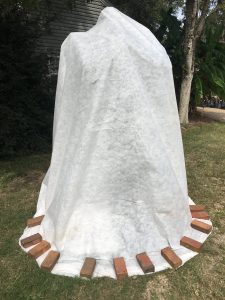There are some protective measures you might employ in your landscape just ahead of the upcoming freezing temperatures for the more cold-sensitive plants.

Coverings protect more from frost rather than from extreme cold. Covers that extend to the ground and are not in contact with plant foliage can lessen cold injury by reducing radiant heat loss from the plant and the ground. In other words, covers that extend to the ground help capture and hold in heat coming up from the ground during clear, cold nights. Foliage in contact with the cover is often injured because of heat transfer from the foliage to the colder cover. Some examples of coverings are cloth sheets, quilts or plastic. A word of caution with plastic: It is necessary to remove plastic covers during a sunny day or provide ventilation of trapped solar radiation. I avoid the use of plastic coverings for this reason. The excessive heat buildup under the plastic during a sunny day can do much damage to the plant. A 100-watt incandescent lightbulb under a cover is a simple method of providing heat to less cold-hardy plants in the landscape. A simple way to attach and support the lightbulb is on a landscape shepherd’s hook. You’ll need to use an outdoor extension cord to power the light. Make sure to position the light so that it is not in direct contact with the covering or too close to the plant branches, stems or leaves. It may be impossible to cover large, mature shrubs and trees.
Even if a light bulb or other heat source is not used, covering cold-sensitive plants can reduce the amount of cold, particularly if the cover extends down to the ground.
The use of mulch is a cold protection measure that causes some confusion. If the temperature drops below freezing for just a few hours, a good layer of mulch often will lead to increased cold damage to the tops of your plants. This top injury results from mulch keeping ground heat in the ground away from leaves and branches. So, if a brief, overnight freeze is forecast, you might want to pull the mulch back from your plants. But longer periods of very cold weather are a different matter. If you expect it to get so cold that the tops of the plants may be killed regardless of what you do, leave the mulch in place. It may hold enough ground heat to keep the plant’s roots from being frozen. A plant may come back from considerable cold damage to foliage and branches. But if the roots are frozen, the entire plant may be lost.
Watering landscape plants before a freeze can help protect plants in cases where we get a dry cold front. However, most of our cold fronts bring rain first followed by clear skies and cold air. Moist soil will absorb more solar radiation than dry soil and will reradiate heat during the night. This practice elevates minimum night temperatures in the canopy of plants by as much as 2°F. But the root area needs to be moist and the cover in place well before the freeze arrives in order for this to work.
Plants in containers can be moved into protective structures. Containers that must be left outdoors should be protected by mulches and pushed together before a freeze to reduce heat loss from container sidewalls.
 1
1
